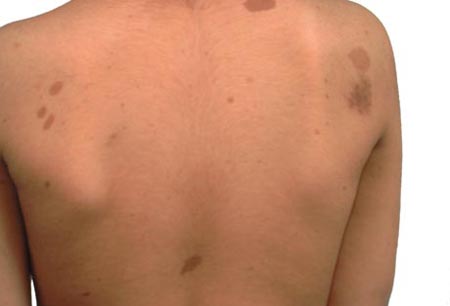Summary
Definition
History and exam
Key diagnostic factors
- family history of NF1
- pain, any location
- neurologic deficits: gross motor delay, general incoordination, school performance problems
- compromised vision
- compromised social interactions
- skin: café au lait spots, axillary freckling, cutaneous juvenile xanthogranulomas, neurofibromas
- head and neck: unilateral diffuse plexiform neurofibroma divisions of the trigeminal nerve
- ophthalmologic: visual compromise, optic disk pallor, iris Lisch nodules
- central nervous system: signs of hydrocephalus, brain tumors, and/or cerebellar abnormalities
- peripheral nervous system: palpable mass about neck, brachial plexuses, groin, Hunter canal, or the popliteal fossae
- skeletal: tibial dysplasia or pseudarthrosis, sphenoid wing dysplasia, pectus excavatum or carinatum, genu valgum or varum, ankle valgus, pes planus
- gastrointestinal: severe constipation, obstipation, abdominal pain, gastrointestinal bleeding
- vascular: neurologic problems, abdominal pain (and/or hemorrhage)
- autism spectrum disorder
- vascular: hypertension
Risk factors
- parent with NF1
- severe crush trauma
Diagnostic tests
1st tests to order
- MRI and/or CT scans
- PET scan
- biopsy
- genetic testing to confirm NF1 mutation
Treatment algorithm
pheochromocytoma
malignant peripheral nerve sheath tumor
neurofibromas: noncutaneous
cutaneous
headache
nervous system
eye
oral
skeletal
vascular
gastrointestinal
hematopoietic
psychological
pregnancy-related
Contributors
Authors
D. Gareth Evans, MD, FRCP
Professor of Medical Genetics and Cancer Epidemiology
Genomic Medicine
School of Medicine
University of Manchester
Manchester
UK
Disclosures
DGE is an author of several studies referenced in this topic. He receives consultancies from Astrazeneca, Springworks, and Recursion. These may impact on recommendations for MEKi treatment.
Acknowledgements
Professor D. Gareth Evans would like to gratefully acknowledge Dr Vincent M. Riccardi, a previous contributor to this topic.
Disclosures
VMR is an author of several studies referenced in this topic.
Peer reviewers
Bruce R. Korf, MD, PhD
Professor
Department of Genetics
University of Alabama at Birmingham
Birmingham
AL
Disclosures
BRK declares that he has no competing interests.
Patrick Morrison, MD
Consultant in Clinical Genetics
Department of Medical Genetics
Belfast HSC Trust
Belfast
UK
Disclosures
PM declares that he has no competing interests.
Edward S. Tobias, BSc (Hons), MBChB, MRCP (UK), PhD
Clinical Senior Lecturer and Honorary Consultant in Medical Genetics
Institute of Medical Genetics
Yorkhill Hospital
University of Glasgow
Scotland
UK
Disclosures
EST declares that he has no competing interests.
Peer reviewer acknowledgements
BMJ Best Practice topics are updated on a rolling basis in line with developments in evidence and guidance. The peer reviewers listed here have reviewed the content at least once during the history of the topic.
Disclosures
Peer reviewer affiliations and disclosures pertain to the time of the review.
References
Key articles
Riccardi VM. Neurofibromatosis: phenotype, natural history and pathogenesis. 2nd ed. Baltimore, MD: Johns Hopkins University Press; 1992.
National Institutes of Health consensus development conference statement. Bethesda, MD, July 13-15, 1987. Neurofibromatosis. 1988;1(3):172-8.Full text Abstract
Mulvihill JJ, Parry DM, Sherman JL, et al. Neurofibromatosis 1 (Recklinghausen disease) and neurofibromatosis 2 (bilateral acoustic neurofibromatosis): an update. Ann Intern Med. 1990 Jul 1;113(1):39-52. Abstract
Riccardi VM. Neurofibromatosis: phenotype, natural history and pathogenesis. 2nd ed. Baltimore, MD: Johns Hopkins University Press; 1992.
Rodrigues LO, Batista PB, Goloni-Bertollo EM, et al. Neurofibromatoses: part 1 - diagnosis and differential diagnosis. Arq Neuropsiquiatr. 2014 Mar;72(3):241-50. Abstract
Riccardi VM. Neurofibromatosis: phenotype, natural history and pathogenesis. 2nd ed. Baltimore, MD: Johns Hopkins University Press; 1992.
Messiaen LM, Callens T, Mortier G, et al. Exhaustive mutation analysis of the NF1 gene allows identification of 95% of mutations and reveals a high frequency of unusual splicing defects. Hum Mutat. 2000;15(6):541-55. Abstract
Listernick R, Ferner RE, Liu GT, et al. Optic pathway gliomas in neurofibromatosis-1: controversies and recommendations. Ann Neurol. 2007 Mar;61(3):189-98. Abstract
Lammert M, Friedman JM, Kluwe L, et al. Prevalence of neurofibromatosis 1 in German children at elementary school enrollment. Arch Dermatol. 2005;141:71-4.Full text Abstract
Evans DG, Baser ME, McGaughran J, et al. Malignant peripheral nerve sheath tumours in neurofibromatosis 1. J Med Genet. 2002 May;39(5):311-4. Abstract
Reference articles
A full list of sources referenced in this topic is available to users with access to all of BMJ Best Practice.

Differentials
- Neurofibromatosis type 2 (NF2)
- McCune-Albright syndrome
- Familial café au lait spots
More DifferentialsGuidelines
- Revised diagnostic criteria for neurofibromatosis type 1 and Legius syndrome: an international consensus recommendation
- Neurofibromatosis 1 French national guidelines based on an extensive literature review since 1966
More GuidelinesLog in or subscribe to access all of BMJ Best Practice
Use of this content is subject to our disclaimer